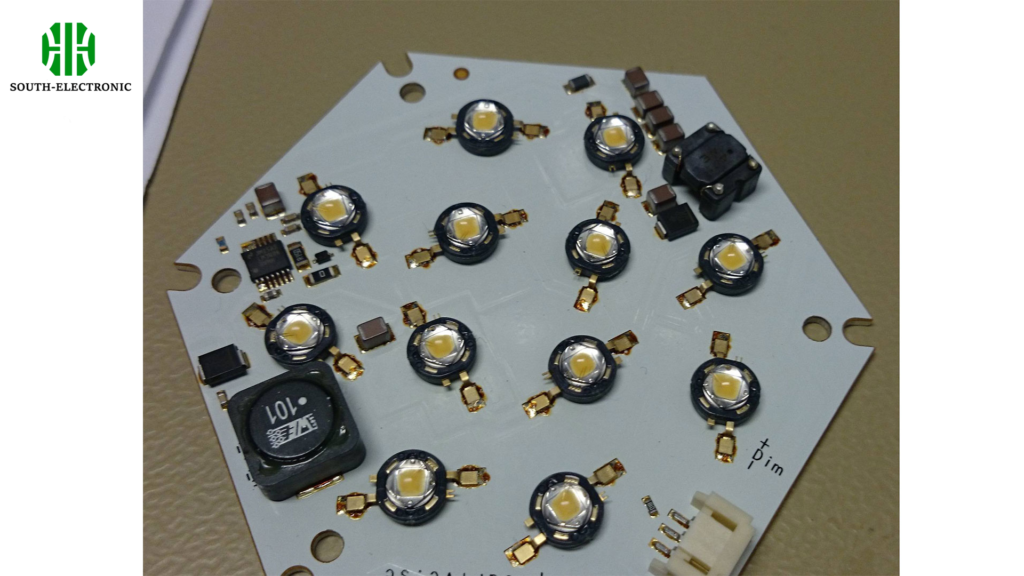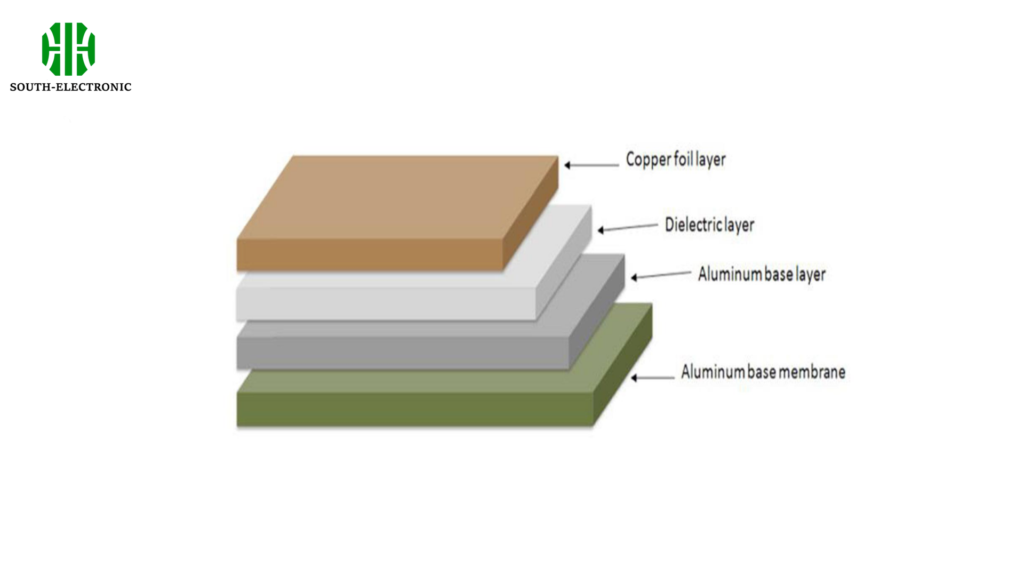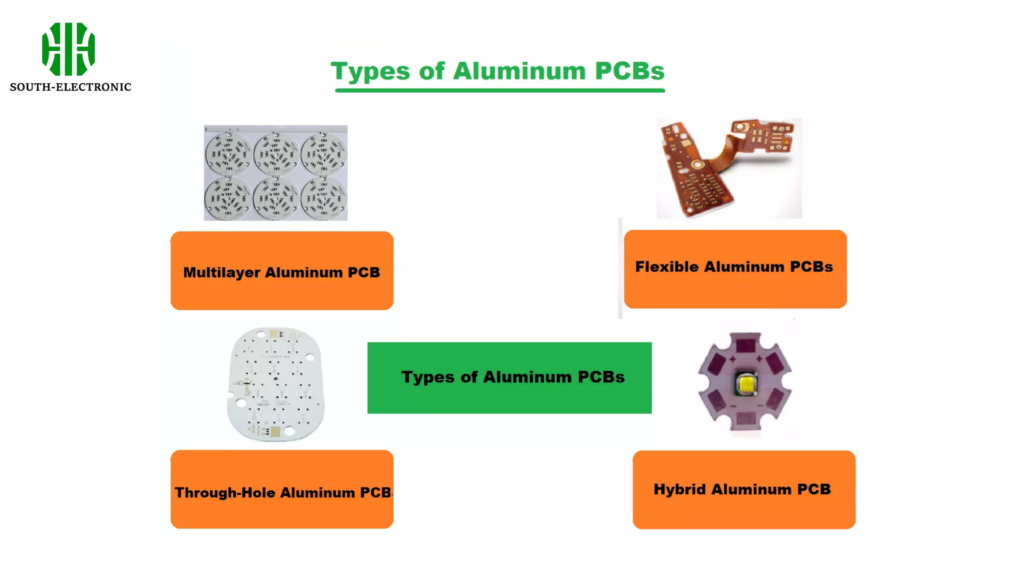What are Aluminum PCBs?
An aluminum PCB is a board that has a metal core (typically aluminum) that supports a copper circuit layer. This construction makes the board dissipate heat much better than non-metal core boards, which makes it great for LED lighting systems, power equipment, and automotive applications.

Structure of Aluminum PCBs
An aluminum PCB, or metal core printed circuit board (MCPCB), is made up of several layers, each with its own purpose. Here’s a breakdown of these layers:
- Copper Layer: The top layer of the PCB where the actual circuit is printed. The thickness of the copper can vary based on the application’s current requirements. It is etched to form the circuit pattern that will conduct electricity.
- Dielectric Layer: Also known as the thermal insulation layer, this layer is crucial for the performance of the PCB. It acts as a barrier between the copper layer and the aluminum base, providing electrical insulation while also conducting heat away from the copper layer. The material used here is typically a thermally conductive but electrically insulating polymer.
- Aluminum Base: The core of the PCB. The aluminum base serves as the mechanical support for the PCB, but its primary role is to spread and dissipate heat generated from the active components on the board. The choice of aluminum can vary in alloy and thickness depending on the thermal performance required.
- Aluminum Base Membrane (optional): Some aluminum PCBs might include a thin protective layer on the bottom of the aluminum base to protect against scratching, moisture, or other environmental factors.

Benefits of Aluminum PCBs
Aluminum PCBs offer several advantages over traditional PCBs, making them a popular choice for specific applications.
- Superior Heat Dissipation: The main thing about aluminum PCBs is that they can dissipate heat really well. Aluminum is really good at conducting heat, so these PCBs can handle more watts, which makes devices last longer and be more reliable.
- Durable and Reliable: Aluminum is really strong and tough, so PCBs made with it are more stable physically. That makes aluminum PCBs great for applications in harsh environments.
- Cost-Effective: Aluminum PCBs are usually more expensive than regular fiberglass PCBs, but they can be cheaper in the long run because they last longer and are tougher.
Types of Aluminum PCBs
Aluminum PCBs, essential for managing heat in electronic circuits, come in several types to suit different application needs. Here are the main types:
- Multi-layer Aluminum PCBs: These are constructed from several layers containing thermally conductive dielectrics. Designers can embed multiple circuit layers within these dielectrics and use specialized vias to connect them. While effective in many aspects, they are not the best at transferring heat.
- Flexible Aluminum PCBs: These PCBs are made with a flexible type of aluminum, like alloy 5754, and use innovative, flexible dielectrics composed of Polyimide resin mixed with ceramic fillers. This combination provides excellent electrical insulation and thermal conductivity. The board can be bent into shape during installation but isn’t designed for continual bending.
- Through-Hole Aluminum PCBs: In these complex PCBs, holes are pre-drilled in the aluminum base and filled with a dielectric material to create a core. This allows for the lamination of thermal materials and other PCB layers on both sides of the aluminum base. Post-lamination, additional drilling is done similarly to conventional multi-layer PCBs, with holes that go through the aluminum layers. This type is the most intricate in terms of construction.
- Hybrid Aluminum PCBs: These feature a combination of non-thermal materials and aluminum. Manufacturers process the non-thermal part separately and then attach it to an aluminum base with thermally conductive materials. For example, layering a traditional FR-4 PCB on top of an aluminum base enhances both heat dissipation and the board’s structural strength.

What is the Thermal Conductivity of Aluminum PCBs?
Aluminum is a popular choice for PCBs because it has a high thermal conductivity, which means it can move heat away from sensitive components quickly. The thermal conductivity of aluminum used in PCBs can range from 1 W/mK to 3 W/mK, depending on the type of aluminum and how it’s made. Pure aluminum has a thermal conductivity of about 235 W/mK, which is much higher than the alloys used in PCBs.
How Thickare are Aluminum PCBs?
Aluminum PCBs can be made in a variety of thicknesses, depending on the application. The aluminum substrate itself can range from 0.8 mm to 3.0 mm. However, there are also options for thinner substrates, as thin as 0.5 mm, and thicker substrates, up to 5 mm. The overall thickness of the PCB, including the aluminum base, the dielectric layer, and the copper foil, is adjusted based on the thermal and mechanical requirements of the application. This flexibility in thickness allows for better durability and heat dissipation.
What are the Applicationof Aluminum PCB?

Aluminum PCBs are particularly favored in applications where heat dissipation is crucial. Here are some of the main application areas:
- LED Lighting: Aluminum PCBs are extensively used in LED applications because they reduce the heat that LEDs generate, thereby prolonging the life of the lights.
- Power Supplies: The ability of aluminum PCBs to handle higher temperatures makes them ideal for use in power supplies, where heat generation is significant.
- Automotive Systems: Aluminum PCBs are used in automotive electronic controls, such as in engine control units, because of their ability to withstand high temperatures and provide reliable performance under harsh conditions.
- Consumer Electronics: Devices like power amplifiers and audio equipment benefit from the effective heat dissipation properties of aluminum PCBs.
- Computer Hardware: Aluminum PCBs are used in high-performance devices such as CPU boards and power devices, aiding in heat dissipation and improving performance and longevity.
- Telecommunications: They are used in communication electronic equipment, including high-frequency amplifiers and filtering appliances, where heat stability is necessary.



